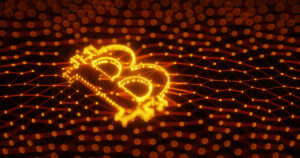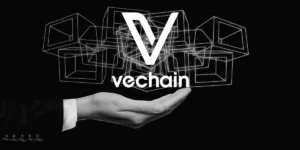
Many who have been following the trends in the technological ecosystem must have heard of blockchain technology. While many might have heard about Bitcoin and cryptocurrencies, a lot may not know that these assets are powered by distributed ledger technology. Others already started to learn about blockchain at the iMi Academy.
But what is blockchain technology? What does a blockchain look like? For these and many questions, we bring you a detailed explanation in this blog post.
A lot of companies in the world including IBM and Microsoft are known to utilize cutting-edge technologies to solve problems in the world today. While they have generally contributed to increasing the quality of life in general, with the advent of distributed ledger technology, blockchain, and its associated innovations, a new shift is brewing. The tech, product, and service legacies of banks, tech firms, and businesses, in general, are set to be improved more.
Read on to get a clearer understanding of what blockchain technology is.
What is blockchain technology & how does it work?
Many people today ask this very generic question: What is the blockchain and what are the advantages of blockchain? Several attempts by many outlets have been made to explain what blockchain technology is. However, the growing use cases around the new technology confuse people more about what blockchain truly is.
When looking for how to explain blockchain to someone new to the technology, it is best to conceive it simply as a digital register. Almost everyone knows what a register is. They are useful in recording information, which can either be a list of items bought for the home or a company’s transactions. Blockchain is like registers that have grown to have various use cases that are changing our world today.
If you’re an absolute beginner then consider reading about distributed ledger vs blockchain to find out what the difference is.
Blockchain technology works by registering data or a piece of information in a decentralized system, thus helping to improve data integrity. In this article, we will explore in detail the way blockchain technology works. It is good to know that blockchain is the technology upon which Bitcoin, Ethereum, and other cryptocurrencies are built.
The use cases or applications of the technology are always increasing. While many may define the growth of the technology per innovations that anchors it today, it is still a new technology with more room to grow.
A simple definition of blockchain
Blockchain technology definition can come once a basic understanding of blockchain has been gained. In a coherent and simplified way, we can define blockchain as a system of recording data or information on a distributed ledger, in a bid to make it difficult to be changed or tampered with.
Blockchain explained simply may be more expressive when we consider blockchain to be a system of storing information in sections called blocks. Each block has its own capacity, and when this capacity is attained, it is sealed and chained to the preceding blocks. All this happens automatically, without control from a single individual. All of the participants contributing to a blockchain network are distributed across an interconnected network.
The information stored in each block is visible to everyone and cannot be changed once it has been registered. This makes financial information or data stored on a blockchain to be very transparent.
Our way of explaining a complex technical concept to beginners is using a famous blockchain analogy. Possibly the best blockchain analogy you’ll ever hear is the following:
During an ice hockey game, each player knows the score at any time. You can’t change the score without convincing everyone playing that there is a very good reason for doing so. Right? Well, in a very similar way, each node in a blockchain network has an identical copy of the ledger. And that ledger is immutable.
Therefore, both games achieve the same solution. We have multiple participants who have an agreed record of events and these records cannot be tampered.
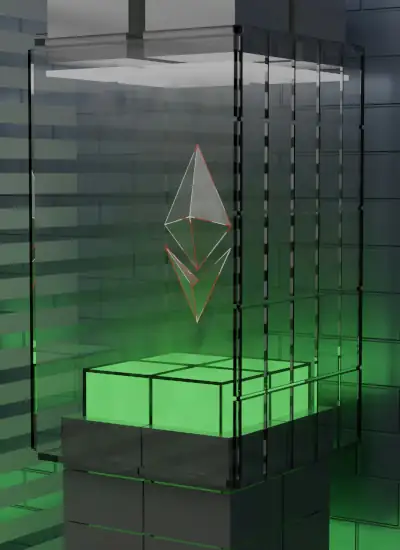
Unlock Your Business Potential with Certified Blockchain Consulting!
Dive into the future of technology with our team of certified blockchain experts. Simply pick the service you need:
Personalized Advice – tailored to your business needs.
Comprehensive Training – for you and your team.
Development Services – innovative solutions from the whitepaper to the finished blockchain.
Programming – with capabilities and tools to succeed.
TALK TO THE EXPERTS TODAYBlockchain definition according to Blockchain.com
Many sources define blockchain technology differently, with each definition of blockchain meaning the same thing. Here is another definition of blockchain according to Blockchain.com:
The term “blockchain technology” typically refers to the transparent, trustless, publicly accessible ledger that allows us to securely transfer the ownership of units of value using public key encryption and proof of work methods. The technology uses decentralized consensus to maintain the network, which means it is not centrally controlled by a bank, corporation, or government. In fact, the larger the network grows and becomes increasingly decentralized, the more secure it becomes.
The definition above presents a more technical overview of the entire concept of blockchain technology. However, the encryption feature as highlighted contributes to keeping the data stored on the network secured. Oftentimes, anyone who makes transactions in a blockchain usually has their identities shielded. This pseudo-anonymity of transactions such as Bitcoin’s and users’ identities remains one of the primary reasons why government authorities are anti-Bitcoin, even though they see the potentials in distributed ledger technologies and blockchain in general.
Our best blockchain explanation in technical terms
Now that we have laid a somewhat broad foundation for this subject matter thus far, we can now take a deeper dive into a blockchain technical explanation. Blockchain technology explained will help us unravel the intricacies of the nascent technology. Blockchain is a special type of distributed ledger technology but designed with extra cryptographic capabilities.
The distributed ledgers, which are also a special kind of database are duplicated and spread across the entire network of computer systems on the blockchain. Each block contains a cryptographic hash of the previous block, a timestamp, and transaction data. Timestamps are essential within the blockchain as it gives the proof that a transaction existed as at when it was added to the block.
There are no limits to either the number of blocks or chains within a particular blockchain and the more widespread a blockchain network is, the more difficult it will be for data recorded or stored to be tampered with. As a distributed protocol, blockchains do not just permit any kind of data to be registered within the chain. Network participants or validators works together using a set of predefined protocols to communicate and confirm the legitimacy of transactions before they are permanently stored within the blockchain.
While the real-life functioning of a blockchain network may appear complicated, the fundamentals are as easy as described, and the capabilities are also easily deployable. The mode of verifying transactions in a blockchain network is designed so as to make this process occur faster and relatively cheaper than what is currently obtainable.
Key industries such as supply chain, financial services, and healthcare amongst others in which Blockchain systems have been integrated have been proven to function more efficiently than alternative options available.
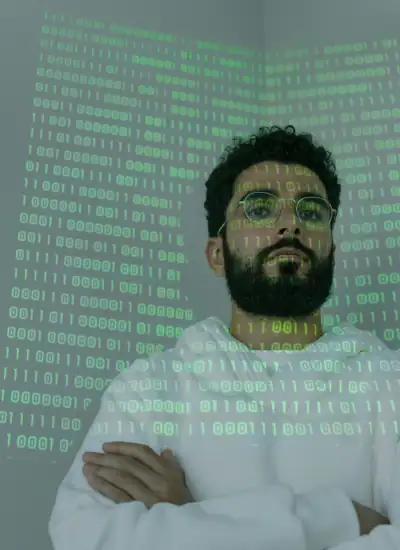
Unlock the Code: Master Blockchain Programming!
Dive into the world of decentralized technology with our comprehensive online programming courses. Learn at your own pace and get:
Access – to expert instructors.
Interactive – coding exercises.
Vibrant – community of like-minded learners.
Certified – receive your recognized diploma.
ENROLL TODAY AND TRANSFORM YOUR FUTURE!How are blockchain transactions verified?
There are different types of blockchain networks today, all of which have their own models for verifying each blockchain transaction. There is the Bitcoin blockchain, Ethereum Blockchain, Tezos Blockchain, Polkadot, as well as other private blockchain networks. Of the various unique ways of verifying transactions, the two most common models are the Proof-of-Work (PoW) models being used by Bitcoin and the current Ethereum blockchains, and the Proof-of-Stake (PoS), being used by Tezos and other smart contract or blockchain applications focused blockchain networks.
In the PoW model, miners are at the forefront of validating or confirming the transactions that are collected within each block. The confirmations are done using hardware miners which help to solve complex mathematical problems. The math problem arose based on the premise that you cannot just add a transaction to a block. Being one of the miners in the network, others are competing to do the same as there is a reward for miners who successfully confirms a transaction.
To win the prize or the reward, the miner must find a correct hash that solves the complex math problem.
PoS systems work differently. The miners in the PoW model are replaced by validators which are usually selected to produce the next block based on their staked interest in the blockchain. To become a validator, you may need to stake a specific amount of tokens. In practice, validators solve no math problem to confirm a transaction within the network, however, their staked amounts can give each validator a competitive edge to confirm more transactions than others with lower stakes.
The PoS model is generally considered to be convenient as it is environmentally friendly. The miners in the PoW runs on electricity, and a considerable cost can be incurred when running the various machines needed to compete favorably in the “hash finding” competition.
Blockchain illustration
With much said those far, you may be wondering, what does a blockchain look like diagrammatically? The image below shows a typical blockchain illustration, detailing how a sender transmits data or funds to the receiver and everything that happens in between.
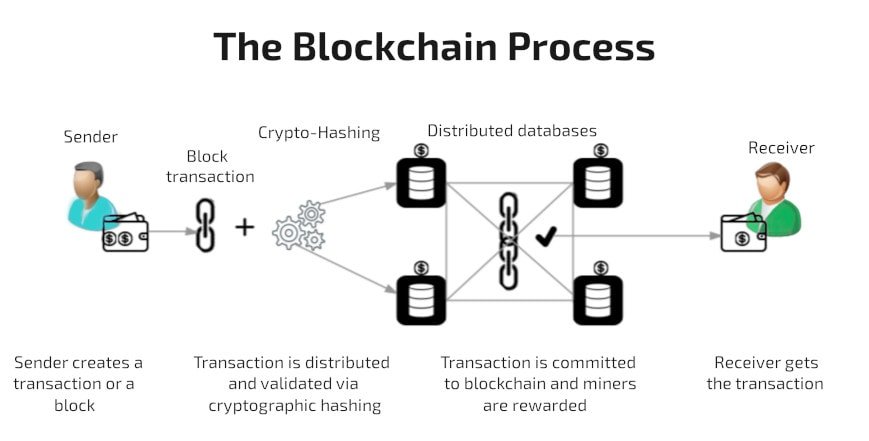
The illustration above is showing how a sender does a transaction to a receiver. The transaction could include digital money, a smart contract, or any other kind of information.
Now, for those of you who want more details on how to write a Block, let’s have a look at a simple coding example of a blockchain.
Blocks in a blockchain do need a Hash, a Tx_Root and each block receives a clear Timestamp. If we want to add different Blocks together (like a Chain) then each block needs to corresponding previous Hash, the Prev_Hash. These blocks then link together and communication in the Blockchain is enabled. The distribution, verification, and transaction will be done by miners. Miners are nothing else than other nodes in the network. So what does a blockchain look like from a programmer perspective?

Of course, there are several advantages to work with blockchain technology. First of all, you can communicate and exchange assets without a 3rd party involved. As each transaction automatically receives a timestamp, traceability is guaranteed. If the sender would change anything on the former ledger (block), each participant (receiver) in the network will be informed. Therefore, fraud can be excluded. Finally, hackers would have to attack each Node within the network separately and hack 51% of them to access your data.
How does blockchain work in everyday applications & industries?
In this section, we are going to be exploring key areas that will answer additional queries many may have. This includes such questions as what does blockchain do? What can blockchain be used for and how blockchain works in various industries or digital ecosystems.
Before we talk about applications and use cases, we’d like to talk about some basic terms which we need to understand.
Blockchain Computing
Blockchain computing defines a revolutionary trustable outcome to share data over the internet. Essentially, a distributed database of records. While we can set up a permissioned blockchain to join, we can also implement a permissionless blockchain that would be truly decentralized.
Blockchain System
A blockchain system defines a network of computers. Due to its decentralized character, a blockchain system is difficult to hack and it’s impossible to change records in a ledger. Such a system is generally speaking a recording of information. It’s all about trust and consensus.
Blockchain Tech
Blockchain as new technology became a real game-changer. Recently, we had a discussion with our partner in New York City about the use of the algorithm of today’s internet. Why people using the term “disruptive” when it comes to blockchain technology. Our common understanding and the outcome of our discussion were clear. This technology is changing the way we do things. Especially when it comes to Banking or IoT (the Internet of Things). It’s not a revolution and sure not disruptive. Much more it is just a new way of coding and distributing information over the internet.
Therefore, everyone should be ready for the future. Hence, we should have a look at some major applications where this technology can be used as a game-changer. So, let us take a deep dive by exploring some key areas blockchain finds its most apparent uses.
Application 1: Hacking
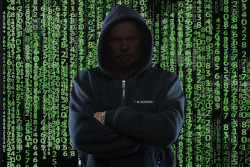
With the advent of blockchain technology, the business of hacking has been significantly impaired. The record-keeping model of open-source or public blockchains across a distributed peer network has made tampering with stored data an unprofitable venture. When a new block is created and filled with stored data, it is sealed through cryptography and mapped unto the previous blockchain in a chain. For a hacker to successfully breach and alter this stored information, he or she will have to hack into each computer node storing the data. This is not realistic in practice.
How secure is blockchain?
As highlighted, blockchain is fundamentally secure as malicious actors will find it impracticable to breach into the networks of every network participant.
While blockchain networks are not entirely immune to hacking, the incidence hardly happens. Hackers rather take to the startups or companies building businesses around the technology such as digital currency trading platforms. Most Fintech and financial institutions that are able to invest in the right computing power are beginning to leverage the distributed nature of blockchains to secure their businesses.
Application 2: Cryptocurrency

Cryptocurrencies are also called virtual currencies, and their existence has generated a lot of hype in the past decade. The first digital asset is Bitcoin, created by a developer, or group of people with the pseudonym Satoshi Nakamoto. Satoshi published the Bitcoin white paper, bringing to life the first broadly acclaimed representation of Blockchain technology.
Following Bitcoin, other inventors, such as Vitalik Buterin, Changpeng Zhao, Charlie Lee amongst others have developed alternative digital currencies Ethereum, Binance Coin, and Litecoin respectively. All these cryptocurrencies are developed using Blockchain technology as their underlying technological infrastructure.
How does Bitcoin use blockchain?
Bitcoin transactions or those of any cryptocurrency are stored in blocks as described earlier. These transactions are open to everyone, however, the identity of those using the Bitcoin network is hidden. The peer-2-peer nature, as well as the privacy of cryptocurrencies built on the blockchain, has fueled the massive embrace of these new forms of digital money.
Through blockchain and cryptocurrencies, a new digital economy has been created. People all over the world now invest in and trade each of these digital currencies whose values are known to increase as people embrace their unique utilities. The potentials to embrace cryptocurrencies is high because when compared to the traditional electronic cash system, it offers a faster and relatively cheaper method of transferring funds.
Also, digital currencies are evolving in nature, as blockchain developers diversify their use cases. Today, we have decentralized finance protocols that seek to directly compete with lending, borrowing, and other core investment products on offer by Central Banks backed financial institutions. In general, the more than 9,700 digital currencies around today are all on track to revolutionize money, cash transactions, and investment opportunities associated with fiat currencies.

Unlock Your Crypto Potential: Become a Market Maverick with Expert Coaching!
Are you ready to dive into cryptocurrency but need some advice? With our personalized 1:1 coaching, you’ll learn to:
Understand – the fundamentals of cryptos and how they impact value.
Navigate – through the volatile crypto market with confidence.
Identify – new lucrative opportunities that maximize returns.
Manage – exchanges and risk to protect your investments.
BOOK EXPERT COACHING NOWApplication 3: Banking

The banking sector around the world is undergoing remarkable competition from cryptocurrencies, as per cross-border cash transfers and settlement. While digital currencies are hard to beat, banks are beginning to invest heavily in blockchain technology. These bring increased transparency to their transaction processes as well as the other areas in which blockchain technology comes into play.
Specific ways banks utilize blockchain
The recording of transactions directly on the blockchain helps banks to settle transactions faster, and with reduced costs. To settle cash transactions, particularly when related to cross-border payments, banks do not have to rely on any central authority or a network of custodial services such as SWIFT as they could simply settle transactions directly on a public blockchain.
Besides cash settlements, banks can also improve their securities trading processes using blockchain technology. By removing the middlemen, the acquisitions and sales of securities including stocks, commodities or debts can be tracked using blockchain. The record-keeping for these ventures is condensed and can be monitored by every person of interest in the transaction.
Other key areas blockchain can be deployed for use in the banks include Credit issuance and loans, trade finance, and digital identity verification.
Application 4: Real Estate

Part of the real-world uses of blockchain technology takes place in the real estate industry. Property owners can use blockchain technology to manage their properties in terms of payments, maintenance, and more.
Unique ways blockchain technology impacts real estate
Blockchain technology makes it easy for real estate properties to be tokenized. Through this tokenization, real estate assets can be transferred easily to new owners with other prominent benefits aiding property managers to manage resources better.
Detailed explanations of how tokenization is revolutionizing real estate and other industries can be found in our comprehensive blog post here.
Application 5: Healthcare and Pharmaceutical Industry

Here is another industry where blockchain technology is capable of overhauling completely. The healthcare and pharmaceutical industry generates a lot of data that can easily be stored on the blockchain both for preservation and for transparency.
Patients Health records are often required to be kept confidential. This can be achieved using blockchain technology. The coronavirus pandemic brought to the fore the exact ways in which blockchain-based applications can be used to track and prevent COVID-19 infections. With the storage of patient’s health records on a modified distributed ledger, access can be granted to the patient to share the data with necessary individuals or authorities.
Data exploitation and intellectual property theft related to health and biopharmaceutical researches can also be prevented when the data is stored on the blockchain.
Application 6: Supply Chain

With blockchain technology, the global supply chain can be improved remarkably. By recording or mapping the movement record of goods from one point to the other, manufacturers, suppliers, retailers, and other persons of interest can easily keep track of the goods in transit. This can significantly increase the efficiency of the parties involved and expedite the farm to fork delivery of products.
Application 7: E-Voting

Even individual identities can be created and secured with blockchain. Therefore, e-Voting became the major application for government initiatives to decrease manual work and to ensure the correctness of the count. Electronic voting without using blockchain technology would be absolutely insecure.
Key takeaways on understanding blockchain technology
Understanding blockchain technology in its entirety may take more than just reading a few pages. While we have attempted to demystify the concept surrounding this new technology in this article, you may wish to take a look at our blog to gain a broader overview of blockchain in practice through other broad content we have published.
Blockchain technology is a futuristic innovation that has the right technical fundamentals for it to be applied to most industries. Blockchain technology finds unique applications in the evolution and growth of digital currencies, in preventing the growing incidence of hacking, as well as in revamping the global supply chain amongst other use cases.
In all, anyone can learn about blockchain coding and develop whole new ways that the technology can be used to solve some of the existing problems in the world today. That is one of the beauties of some of the top open access blockchain networks. Anyone can build a new blockchain application on them.
Learn Blockchain Technology!
Blockchain Trainings in small Classes
Webinars about Bitcoin and Coding
Blockchain Courses at University Level
Get free Blockchain Tips!
Get monthly tips on how blockchain can help your business.
On top, you’ll get our free blockchain beginners course right away to learn how this technology will change our lives.
FAQs
Is it blockchain or block chain?
The word is ‘blockchain’, a combination of two separate words. Blockchain is a special kind of distributed ledger technology. The word came about as a result of the mapping of blocks of data to other preceding blocks to form a virtual chain of encrypted verified data. Splitting the word in two will create a different meaning entirely. So, it’s best we stick with blockchain for easy comprehension.
What is a blockchain company?
A blockchain company is a technology firm that builds its business or products around blockchain technology. The evolution of blockchain technology has stirred the emergence of a lot of these companies in the past decade. Blockchain companies offer a diverse range of services. Ranging from operating a cryptocurrency exchange where digital currencies can be bought and sold to those dedicated to creating digital identities.
What is blockchain currency?
A blockchain currency is also a cryptocurrency. They are a relatively new form of virtual money built to run on a blockchain network. Bitcoin, Ethereum, XRP, are some of the popular cryptocurrencies around today. There are a wide variety of these digital currencies including a growing niche known as Decentralized finance-backed tokens. Examples of these tokens include Uniswap, PancakeSwap, and other relatively new tokens.
What is a blockchain platform?
A blockchain platform is a decentralized governance and data infrastructure that permits users to transact with one another without the need for an intermediary. Through a blockchain platform, two or more people can conduct transactions directly, securely, thereby enjoying the speed and low cost of transactions in relation to existing payment platforms. A blockchain platform can be used for more transactions other than cash transfers.
How many blockchains are there?
It is difficult to keep an accurate count of the number of blockchain networks operating today. First, there are private and public blockchain networks that serve various purposes. New blockchain networks are designed on a daily basis, all seeking to outrank the other in terms of gaining market share. Examples of the popular blockchains around today include the 6 different types of blockchain networks notably; centralized blockchains, decentralized blockchains, public distributed ledgers, private distributed ledgers, consortium blockchains, and hybrid blockchains.
Some of the top cryptocurrencies also run on their own specialized blockchains. Examples of these include the Bitcoin blockchain, Ethereum network, Binance Smart Chain, and Polkadot to mention a few.


